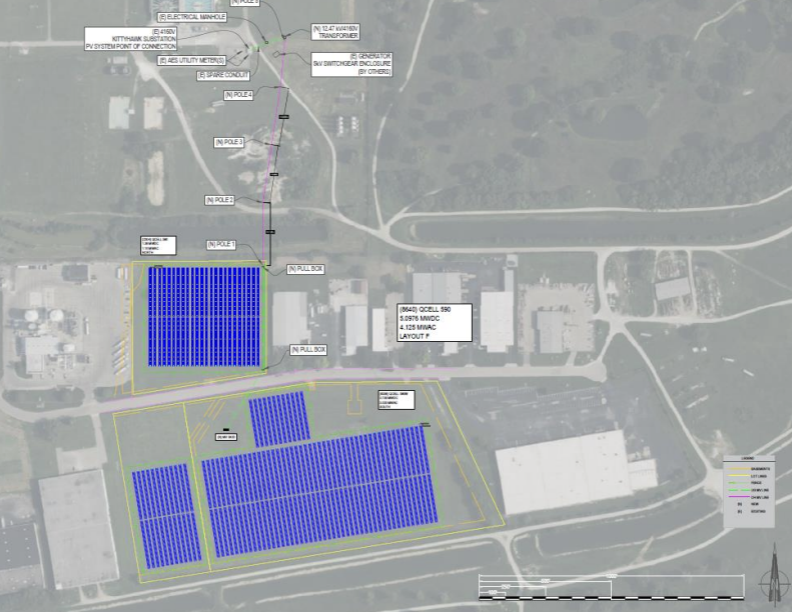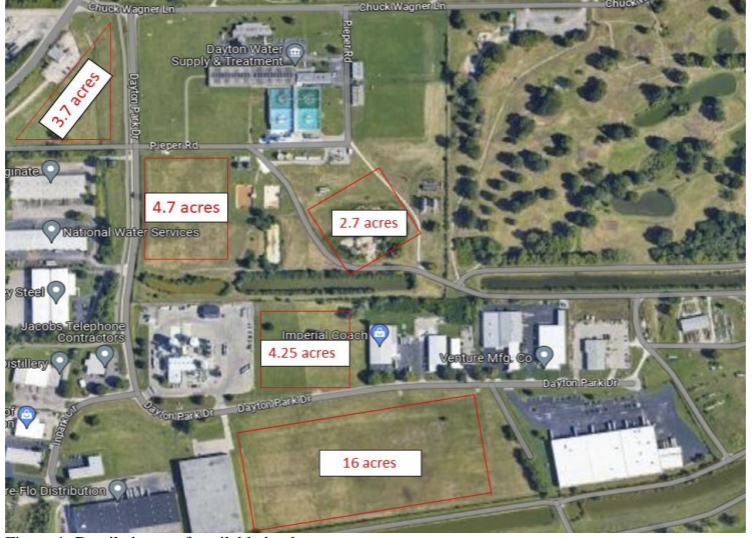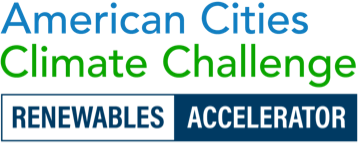Local Government:
Dayton, OhioProject:
Municipal Water Treatment Plant Solar ProjectCategory:
On-Site SolarProject Purpose
To power part of the City’s energy-intensive water treatment facility with 5.15 megawatts (MW) of solar, reduce operational costs, repurpose a long-vacant brownfield into a clean energy asset, and advance Dayton’s 2035 goal of 100% renewable electricity for municipal operations.

Project Overview
In 2025, the City of Dayton approved its first large-scale solar project — a 5.15 MW DC array that will power 38% of the City’s Miami Water Treatment Plant’s electricity needs through a solar power purchase agreement (PPA) with IGS Energy. The array will be installed on a 20-acre brownfield site that previously housed a Sherwin-Williams warehouse destroyed by a fire in 1987 and had limited redevelopment potential due to past contamination.
The City planned and procured the project over 4 years, including analyzing feasibility, seeking third-party modeling of system sizes, and managing a competitive procurement process. Construction is expected to begin in early 2026.

Dayton’s project is also noteworthy for its customized metering arrangement negotiated with its utility, AES Ohio, to allow solar from adjacent sites to connect directly to the water treatment plant’s master meter. This means the electricity generated powers the facility, reducing the amount of power the City has to buy from its utility. Typically, this type of connection is only allowed for systems sited directly on or next to the facility. The project is expected to save Dayton approximately $3.75 million over 30 years.
What is the impact of the project?
The solar project will provide multiple economic and environmental benefits to both municipal operations and the community overall:
- Reducing Energy Consumption and Air Pollution from Municipal Operations: The solar project will supply approximately 38% of the facility’s yearly needs, offsetting 2.2% of annual municipal carbon dioxide emissions. This single project demonstrates tangible progress toward Dayton’s 2035 goal of powering municipal operations with 100% renewable electricity.
- Generating Long-Term Savings: The project is expected to save Dayton $125,000 annually — an estimated $3.75 million over 30 years — and expects to see net savings on its electricity bill by year 4 compared to what the City would have paid without the project.
- Helping Manage Customer Water Rates: Dayton will not only generate operational savings but also reduce the water treatment plant’s risk exposure to electricity price increases outside of the City’s control that would ultimately be passed on to the 1.5 million people it serves.
- Repurposing a Brownfield Site: The project transforms a long-abandoned, contaminated location into a strategic site to host clean energy — demonstrating how brownfields can support municipal operations and renewable energy goals while avoiding development of green space.
“Solar is a smart way to turn underutilized or hard-to-develop sites — even those that might otherwise be eyesores — into assets that generate clean energy and revenue. Projects like this reflect our commitment to being good stewards of taxpayer dollars while cutting emissions, saving money, and showing our residents that sustainability and fiscal responsibility can go hand in hand.”
Meg Maloney, City of Dayton Sustainability Manager
How was the deal structured?
The City signed a 30-year power purchase agreement (PPA) with the developer IGS Energy (IGS). In a PPA structure, the City does not own the solar project; rather, it pays for the power that the solar panels produce, not for the infrastructure built.
Under this agreement, IGS will finance, build, own, and maintain the solar project and claim federal tax credits. Dayton will buy the electricity generated by the project at the fixed rate of 9.22 cents per kilowatt-hour (kWh). For context, as of January 2025, Ohio’s average electricity rates for residential and commercial customers were 15.64 cents/kWh and 10.64 cents/kWh, respectively. In parallel, the City negotiated a lease agreement allowing IGS to develop and maintain the project on City-owned land.
This PPA and site lease approach enables the City to benefit from clean energy without having the responsibility of operations and maintenance.
What can other local governments learn from Dayton’s innovative approach?

Turn Brownfields into Clean Energy Assets: The City transformed a 16-acre contaminated and abandoned Sherwin-Williams site — once the location of a 6-day industrial fire — into an asset that powers critical municipal services and reduces energy costs. Local governments with underutilized brownfields should explore whether their sites can be turned into “brightfields” — or clean energy on brownfields. In fact, thanks to the lessons learned from this project, Dayton is now prepared to take on more complex solar projects in the future such as the Valleycrest Landfill, a 102-acre former Superfund site that the City has cleaned up and is evaluating for solar installation.
Explore Flexible Metering to Unlock New Sites: To reduce project permitting costs and support interconnection, Dayton worked with AES Ohio to waive interconnection fees and allow solar from two adjacent sites to connect upstream of the water treatment plant’s master meter. Typically, behind-the-meter solar projects need to be located on the same property as the energy user, but Dayton’s early collaboration with its utility resulted in a more flexible ‘adjacent metering’ to serve the plant directly by treating nearby land as functionally behind-the-meter.
Leverage Internal Coordination & External Support to Manage Project Complexity: Dayton’s solar project has been shaped by strong cross-department efforts. The Office of Sustainability coordinated with staff from the Water Department, the Department of Planning, Neighborhoods, and Development, the Department of Public Works, and City Manager’s Office. For example, engineers and plant managers from the Water Department ensured the design met operational needs, while the Economic Development team helped resolve title issues to keep the project moving forward. The City also worked with multiple external partners: Go Sustainable Energy provided technical guidance, and outside legal counsel helped the City navigate its first Power Purchase Agreement. Dayton also worked with AES Ohio to waive interconnection fees.
“Cities and utilities have a real opportunity to be creative partners in advancing innovative projects. We brought AES Ohio to the table early, and that early collaboration opened the door to more flexible, solution-oriented thinking. When utilities are part of the process from the beginning, they’re more invested in finding ways to make projects work—not just for the city, but for their own grid priorities like resilience and reliability. It’s a win-win that ultimately benefits both residents and the utility.”
Meg Maloney, City of Dayton Sustainability Manager
What advice would Dayton give other local governments as they pursue clean energy projects?
Start with On-Site Solar Projects for Larger Municipal Facilities: If a city is new to investing in clean energy projects, siting solar on or adjacent to energy-intensive facilities — like water treatment plants, airports, or recreation centers — typically offers both operational and cost benefits. Connecting a project behind-the-meter is also typically one of the most straightforward paths for project interconnection. To learn more about on-site solar, check out this Procurement Guidance and this example from San Antonio of multi-site, on-site solar to get greater economies of scale.
Pursue Multiple Financial Strategies to Maximize Financial Benefits: Dayton’s approach shows how cities can advance clean energy projects with limited financial resources by leveraging creative funding, embracing a third-party ownership model, and right-sizing the project. Dayton used proceeds from a utility settlement with AES Ohio, the local distribution utility, to fund early-stage planning (including a $36,000 independent feasibility study). These funds enabled the City to assess the project’s technical and financial viability without drawing from its general budget. As discussed above, by using a PPA structure, the City avoided budgeting for upfront capital costs and pays only for the electricity generated by the system. Lastly, rather than aiming to maximize electricity generation, the City optimized solar project sizing to avoid higher PPA rates associated with the capacity and transmission charges of a larger system.
Highlighting Project Economics for Leadership and Public Buy-In: Even if solar projects are pursued to advance established climate or energy goals, making a strong financial case can be valuable for gaining leadership and public support. In Dayton’s case, clearly demonstrating the project’s economic benefits helped secure buy-in from their decision-makers. Very few municipal infrastructure investments (roads, parks, etc.) generate savings or have a financial return on investment, but well-designed behind-the-meter clean energy projects certainly can result in such economic benefits. For more guidance on how to make the case to key decision-makers, check out this suite of “pitch deck” templates and resources.
What were Dayton’s biggest challenges in setting up this project?
Although the City owned both the water treatment plant and the former Sherwin-Williams site, the latter site had old leases that had not been formally terminated and outdated easements still in place. These legal issues, buried in decades-old records, took the Dayton team around six months to clean up and secure title insurance and jeopardized the project. This experience highlights the importance of starting legal and land use reviews early — even for already publicly-owned land — and assembling the appropriate team to help advance a multi-faceted project.
“I hadn’t anticipated how critical title work would be to clearing the way for the project, especially when it came to land use and ownership complexities. Our Economic Development team’s involvement ensured we avoided costly delays and were able to move forward with a strong foundation.”
Meg Maloney, City of Dayton Sustainability Manager
How does this project fit into Dayton’s broader community goals?
The project is a step towards fulfilling Dayton’s broader climate commitments to secure 100% renewable electricity for municipal operations by 2035 and for the entire community by 2040. The City focused on high-usage city facilities like water treatment plants, which are both major energy users and emissions sources. This not only directly supports local solar but also demonstrates tangible benefits to taxpayers that could increase community buy-in for future projects.
Additional Information and Resources
- New Solar Array to Power Water Treatment Plant (City of Dayton—March 2025)
- Request for Proposal for Solar Power Purchase Agreement at the Miami Water Treatment Facility (City of Dayton RFP No. 23-025CMO—September 2023)
- Request for Proposal for Ground Mount Solar Feasibility Study at the Miami Treatment Plant and Water Reclamation Plant (City of Dayton RFP No. 21-022CMO—June 2021)
- City of Dayton 2019 Greenhouse Gas Inventory (City of Dayton—December 2022)
- Declaration of a Climate Emergency and Commitment to Renewable Resources (City of Dayton Emergency Resolution No. 6572-21—2021)
- Dayton City Commission Meeting: Office of Sustainability Presentation on Solar Project (YouTube Recording—March 2025)
